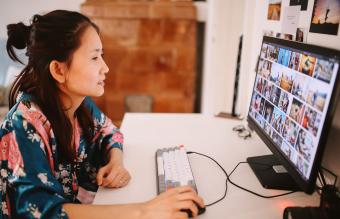
Whether you're trying to shoot photos of your son's football game or capture the perfect image for your Christmas holiday layout, nighttime digital photography tips will make it easier to get the shots you need.
Common Nighttime Photography Problems
Many scrapbookers who have no trouble capturing picture-perfect images during the day find nighttime digital photography to be a challenge. Common problems include:
- Photos are unfocused or blurry.
- The image lacks crucial details.
- The image is too dark.
- There are unattractive glare spots.
- People in the photos suffer from a bad case of red-eye or washed out faces.
Nighttime Digital Photography Tips
Remember these nighttime digital photography tips as you're planning your next scrapbooking project:
- Make sure you have realistic expectations. While you don't need a professional-level camera to capture good nighttime photos, you're not going to get gallery worthy photos with a low-end discount digital camera. Part of the reason why some digital cameras come with a higher price tag is that they have features that make it easier to work under low light conditions.
- Read your owner's manual. Most digital cameras will have a section of the manual that recommends nighttime photography tips.
- If possible, try to arrange shots to be taken at dusk. The added light will help illuminate details that are easily missed in a completely dark environment, adding a dramatic flair to your photos.
- Use the flash with care. While your camera's flash works well for many types of shots, for nighttime images it often results in overexposed pictures and subjects with a bad case of red-eye.
- Use a tripod whenever possible. Camera shake only intensifies common nighttime photo problems.
- Adjust your ISO to a higher setting. By enhancing your camera's sensitivity, you'll help to reduce blurriness.
- Increase your exposure time. Typically, a longer shutter exposure will help you to capture sharper nighttime images.
- Use "bracketing" to your advantage. This technique involves adjusting your camera settings in small increments, taking several photos on each possible setting. This will help compensate for any minor errors in your calculations.
- Take as many photos as you can. Since digital photography eliminates the cost associated with buying and developing film, you don't need to be afraid to experiment. The more shots you take, the higher the chance you'll find the perfect image for your scrapbooking project.
Working with the Photos You Already Have
While nighttime digital photography tips can help you learn to capture better photos for your layouts, what do you do with the prints you already have? If you're trying to design a project that features poor nighttime photos that hold special memories, consider implementing one of the following creative scrapbooking strategies:
- Crop images to improve the composition.
- Use creative application of stickers or other embellishments to hide glare spots.
- Buy a red-eye reduction pen from your local craft store to use on old prints.
- Scan your photos and use digital image editing software to apply filters that may help improve the appearance of the picture.
- Have your photos reprinted in black and white to help camouflage unflattering colors.
- Stash unattractive photos in pretty page pockets or mini books that open to reveal images and extra journaling.
- Add a layer of journaling printed on vellum over a collage of nighttime photo images. This will soften the look of imperfect photos and add an artistic touch to your project.
Additional Resources
For more nighttime digital photography tips, consider picking up one of the following helpful reference books:
- Night and Low-Light Techniques for Digital Photography by Peter Cope
- The Complete Guide to Night and Low-Light Photography by Lee Frost
- Nighttime Digital Photography with Adobe Photoshop CS3 by John Carucci
- The Complete Guide to Night & Lowlight Photography by Michael Freeman







